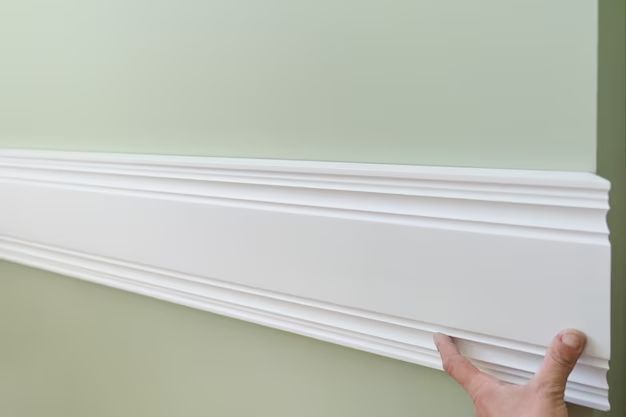When it comes to sticking trim or molding to walls, you have a few good options. The best choice depends on the type of trim, the wall material, and how permanent you need the bond to be. Here’s an overview of some common adhesives and techniques for sticking trim to walls:
Page Contents
Nails/Screws
Nails or screws provide the most secure option for affixing trim to walls. This is the recommended method for heavier or more ornate trim that needs robust support. For lightweight trim, spacing nails every 12-16 inches along trim boards works well. Make sure to pre-drill holes before nailing to prevent splitting the wood. Use finish nails for a cleaner look.
Construction Adhesive
Adhesives like Liquid Nails provide a strong, permanent bond. They work on most wall types and can firmly hold both lightweight and heavy trim, though may require support while drying. Apply adhesive to the back of the trim in a zigzag pattern or continuous beads, then press firmly to the wall for 30-60 seconds to ensure a solid bond. Allow several hours to fully cure.
Double-Sided Tape
For lightweight trim on smooth finishes, high-strength, double-sided carpet tape offers an easy “peel and stick” solution. Prepare surfaces by cleaning thoroughly, then simply remove the tape backing, align the trim, and press firmly into place. It bonds instantly but can be removed in the future without damage. Use for temporary or removable projects.
Finishing Nails
Combining adhesive with finishing nails is a great option for a very secure hold. Nails provide immediate grab while the adhesive sets to form a permanent bond. Simply apply the adhesive, position the trim, then drive nails through the trim into the wall and studs behind. Fill and cover nail holes with wood filler for a seamless look.
Wood Glue
Standard wood glue like Elmer’s forms a strong mechanical bond between porous materials like wood, MDF trim, and drywall. Apply a bead to trim backs, clamp pieces in place until dry, and supplemental nails can be used. Allow several hours to cure fully. Water-resistant versions are best for bathrooms.
Factors When Choosing Adhesives for Trim
When selecting the best adhesive option, consider these factors:
Wall Material
Adhesives bind best to smooth materials like drywall and plaster. Painted or unfinished surfaces allow better grip. Wallpapered walls will need adhesive compatible with the coating. Porous materials like concrete may require a filler primer first.
Trim Material
Adhesives create the strongest bonds with porous materials like natural wood. Plastic or PVC trim limits bonding power. MDF, engineered wood, and lumber offer the best adhesion results. Match the adhesive to the trim type.
Trim Weight and Size
Heavier trim pieces will require very strong adhesives, along with supplemental nails or screws for support. Larger surface areas also require more powerful adhesives than lightweight quarter round. Consider both weight and dimensions.
Temporary vs. Permanent
For trim that needs removal down the road without wall damage, choose temporary options like double-sided tape. Permanent trim can use durable adhesives like construction adhesive for lifelong bonds.
Visibility Matters
Invisible methods like double-sided tape or nails allow hiding trim adhesive. Other adhesives like liquid nails may squeeze out and require cleaning for visible areas.
Choosing the Best Adhesive by Trim Type
Wood Trim and Boards
Natural wood offers the best adhesion for permanent trim. Use bonding methods like:
– Wood glue for cost-effective strong bonds
– Construction adhesive for lifetime permanence
– Combining glue/adhesive with finishing nails
PVC and Plastic Trim
For slick plastic trim, use:
– Double-sided trim tape for easy install and removal
– Clear silicone adhesive for flexibility and grip on plastic
– Construction adhesive formulated for plastics
MDF Trim and Boards
MDF is highly porous for strong adhesive bonds. Good options include:
– Wood glue for affordable bonds to MDF
– Construction adhesive for permanent strength
– Liquid nails for lifetime bonding power
Deco and Lightweight Trim
For decorative or foam trim, use:
– Double-sided trim tape for lightweight pieces
– Clear silicone caulk adhesive if flexibility is needed
– Lightweight liquid nail adhesive for foam trim
Outside and Bathroom Trim
Use moisture-resistant adhesives in wet areas:
– Outdoor construction adhesive for exterior trim
– Waterproof wood glue for bathroom trim
– Bathroom caulk for tub and shower boards
Application Tips for Bonding Trim
Follow these tips when using adhesives for trim:
Clean Surfaces
Remove any dirt, grease, or debris from both the trim and wall for optimal bonding. Wipe with alcohol for best results.
Follow Drying Times
Allow adhesives to fully cure before finishing or painting trim. This prevents failures between layers.
Use Steady Pressure
After applying adhesives, press trim to walls using steady force for 30-60 seconds minimum. This ensures full contact.
Add Supplemental Support
Consider adding small nails or screws with adhesives for heavy trim or additional security. This helps while adhesives dry.
Fill Gaps
Use painter’s caulk to fill any visible gaps between trim and walls after installing for a seamless look.
Conclusion
The best adhesive for sticking trim or molding depends on the specific project needs. Overall, wood glue, construction adhesive, finishing nails, and double-sided tape provide safe options for most trim materials on common wall types. Make sure surfaces are clean before applying adhesive and follow all drying recommendations. With the right preparation and products, you can secure trim firmly in place for beautiful finished results.
